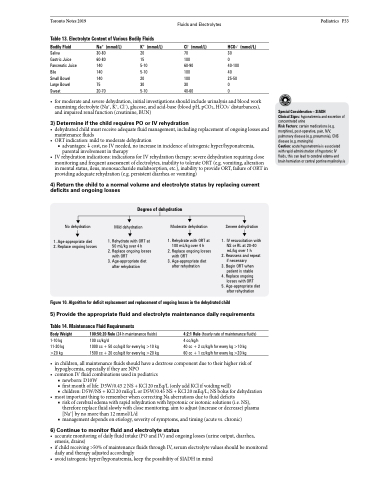Page 1067 - TNFlipTest
P. 1067
Toronto Notes 2019
Fluids and Electrolytes
Pediatrics P33
Table 13. Electrolyte Content of Various Bodily Fluids
Bodily Fluid
Saliva
Gastric Juice Pancreatic Juice Bile
Small Bowel Large Bowel Sweat
Na+ (mmol/L)
30-80 60-80 140 140 140 75 20-70
K+ (mmol/L)
20 15 5-10 5-10 20 30 5-10
Cl– (mmol/L)
70 100 60-90 100 100 30 40-60
HCO3– (mmol/L)
30
0 40-100 40 25-50 0
0
• formoderateandseveredehydration,initialinvestigationsshouldincludeurinalysisandbloodwork examining electrolyte (Na+, K+, Cl–), glucose, and acid-base (blood pH, pCO2, HCO3– disturbances), and impaired renal function (creatinine, BUN)
3) Determine if the child requires PO or IV rehydration
• dehydratedchildmustreceiveadequatefluidmanagement,includingreplacementofongoinglossesand maintenance fluids
• ORT indication: mild to moderate dehydration
■ advantages: i cost, no IV needed, no increase in incidence of iatrogenic hyper/hyponatremia,
parental involvement in therapy
• IVrehydrationindications:indicationsforIVrehydrationtherapy:severedehydrationrequiringclose
monitoring and frequent assessment of electrolytes, inability to tolerate ORT (e.g. vomiting, alteration in mental status, ileus, monosaccharide malabsorption, etc.), inability to provide ORT, failure of ORT in providing adequate rehydration (e.g. persistent diarrhea or vomiting)
4) Return the child to a normal volume and electrolyte status by replacing current deficits and ongoing losses
Special Consideration – SIADH
Clinical Signs: hyponatremia and excretion of concentrated urine
Risk Factors: certain medications (e.g. morphine), post-operative, pain, N/V, pulmonary disease (e.g. pneumonia), CNS disease (e.g. meningitis)
Caution: acute hyponatremia is associated with rapid administration of hypotonic IV fluids, this can lead to cerebral edema and brain herniation or central pontine myelinolysis
Degree of dehydration
No dehydration
1. Age-appropriate diet
2. Replace ongoing losses
Mild dehydration
1. Rehydrate with ORT at 50 mL/kg over 4 h
2. Replace ongoing losses with ORT
3. Age-appropriate diet after rehydration
Moderate dehydration
1. Rehydrate with ORT at 100 mL/kg over 4 h
2. Replace ongoing losses with ORT
3. Age-appropriate diet after rehydration
Severe dehydration
1. IV resuscitation with NS or RL at 20-40
Figure 10. Algorithm for deficit replacement and replacement of ongoing losses in the dehydrated child
5) Provide the appropriate fluid and electrolyte maintenance daily requirements
Table 14. Maintenance Fluid Requirements
2. 3. 4. 5.
mL/kg over 1 h Reassess and repeat
if necessary Begin ORT when patient is stable Replace ongoing losses with ORT
Age-appropriate diet after rehydration
Body Weight
1-10 kg 11-20 kg >20 kg
100:50:20 Rule (24 h maintenance fluids)
100 cc/kg/d
1000 cc + 50 cc/kg/d for every kg >10 kg 1500 cc + 20 cc/kg/d for every kg >20 kg
4:2:1 Rule (hourly rate of maintenance fluids)
4 cc/kg/h
40 cc + 2 cc/kg/h for every kg >10 kg 60 cc + 1 cc/kg/h for every kg >20 kg
• inchildren,allmaintenancefluidsshouldhaveadextrosecomponentduetotheirhigherriskof hypoglycemia, especially if they are NPO
• commonIVfluidcombinationsusedinpediatrics
■ newborn: D10W
■ first month of life: D5W/0.45 2 NS + KCl 20 mEq/L (only add KCl if voiding well)
■ children: D5W/NS + KCl 20 mEq/L or D5W/0.45 NS + KCl 20 mEq/L; NS bolus for dehydration
• mostimportantthingtorememberwhencorrectingNaaberrationsduetofluiddeficits
■ risk of cerebral edema with rapid rehydration with hypotonic or isotonic solutions (i.e. NS),
therefore replace fluid slowly with close monitoring; aim to adjust (increase or decrease) plasma
[Na+] by no more than 12 mmol/L/d
■ management depends on etiology, severity of symptoms, and timing (acute vs. chronic)
6) Continue to monitor fluid and electrolyte status
• accuratemonitoringofdailyfluidintake(POandIV)andongoinglosses(urineoutput,diarrhea, emesis, drains)
• ifchildreceiving>50%ofmaintenancefluidsthroughIV,serumelectrolytevaluesshouldbemonitored daily and therapy adjusted accordingly
• avoidiatrogenichyper/hyponatremia,keepthepossibilityofSIADHinmind


